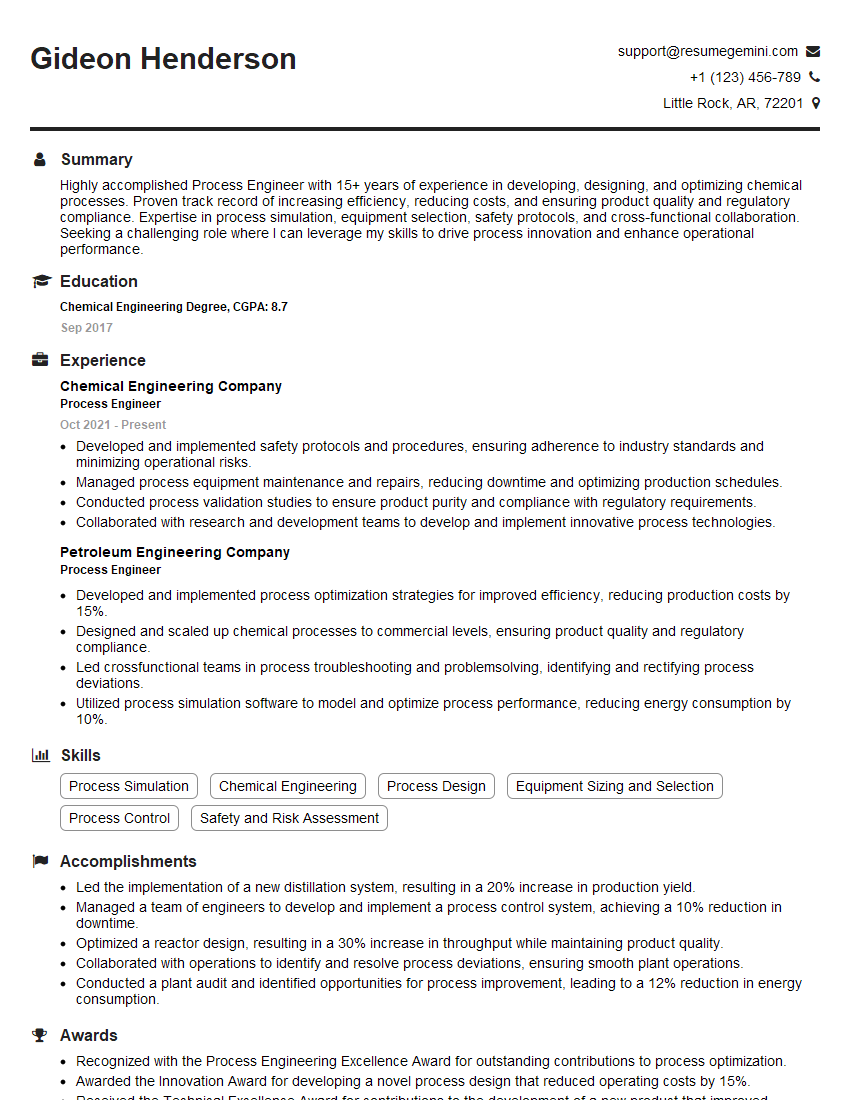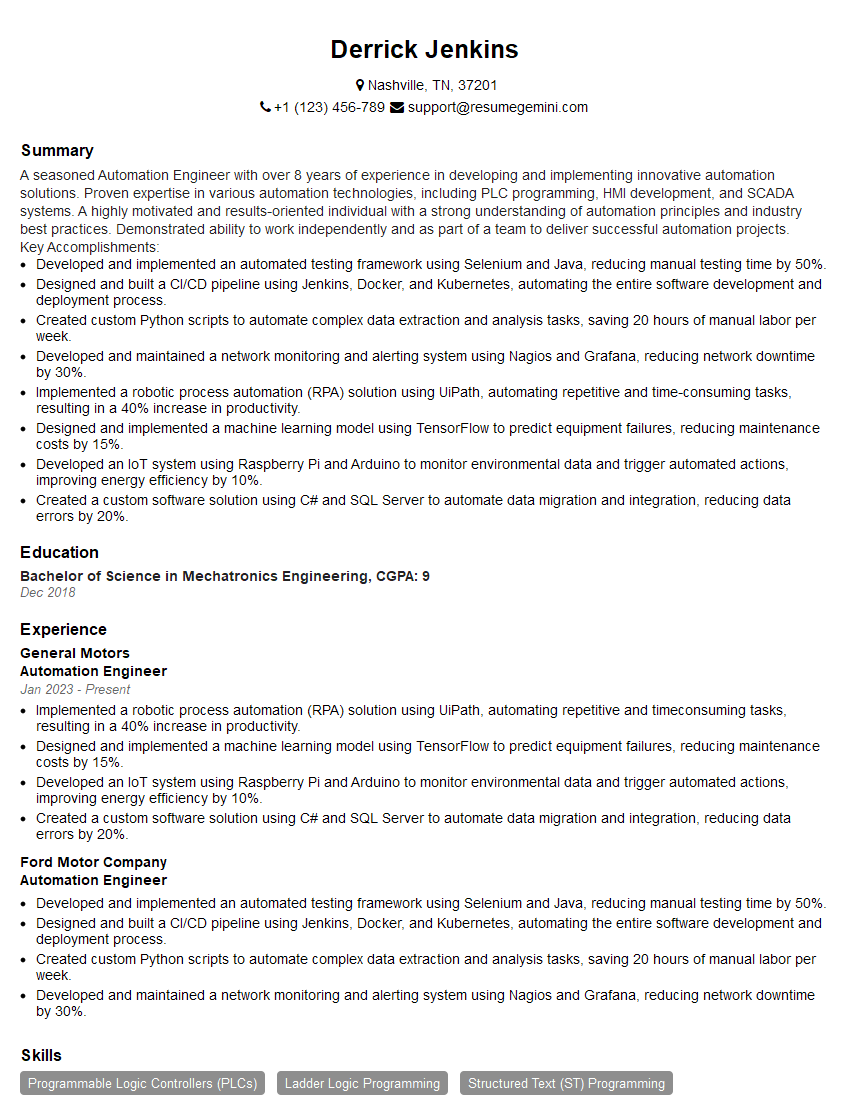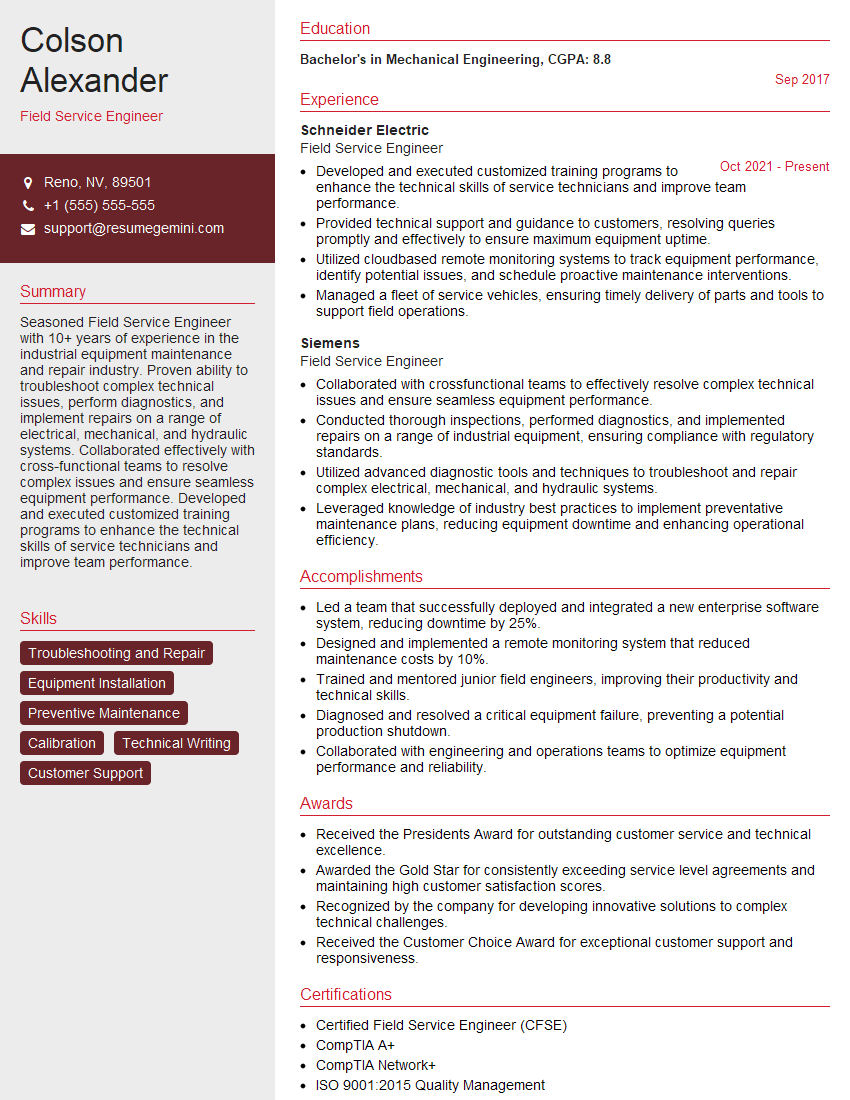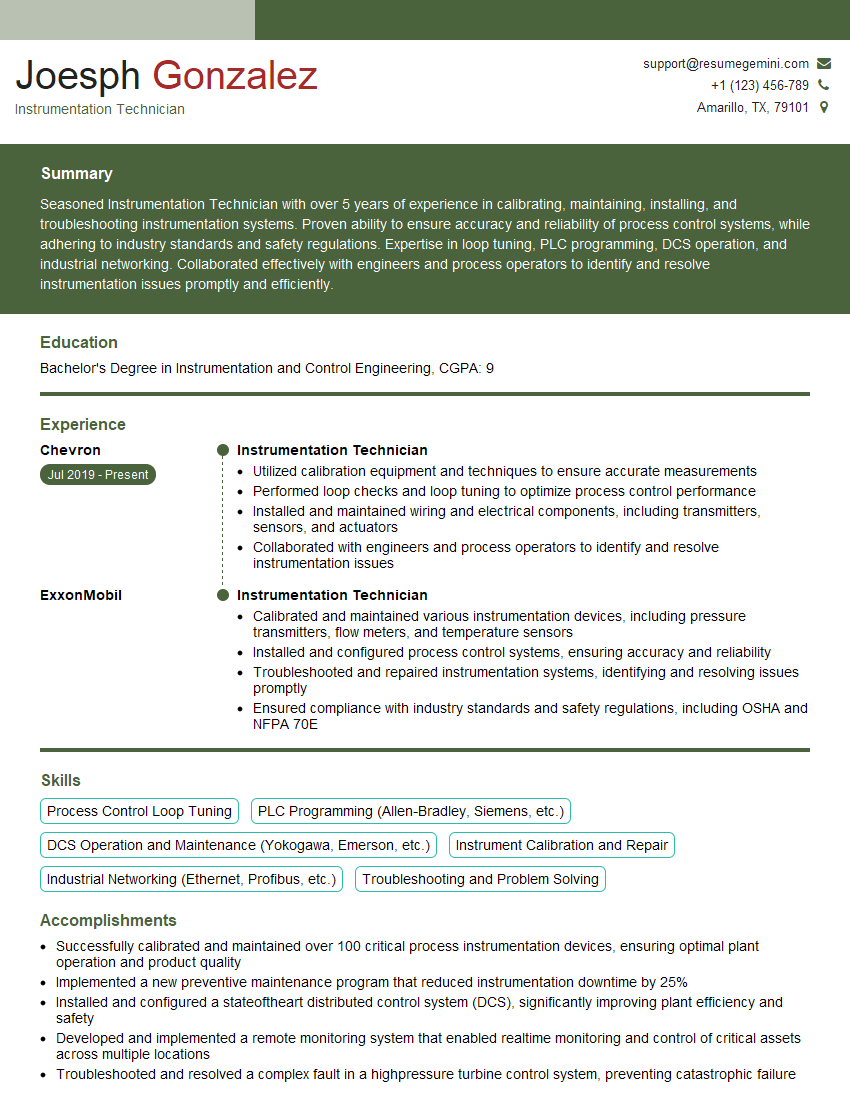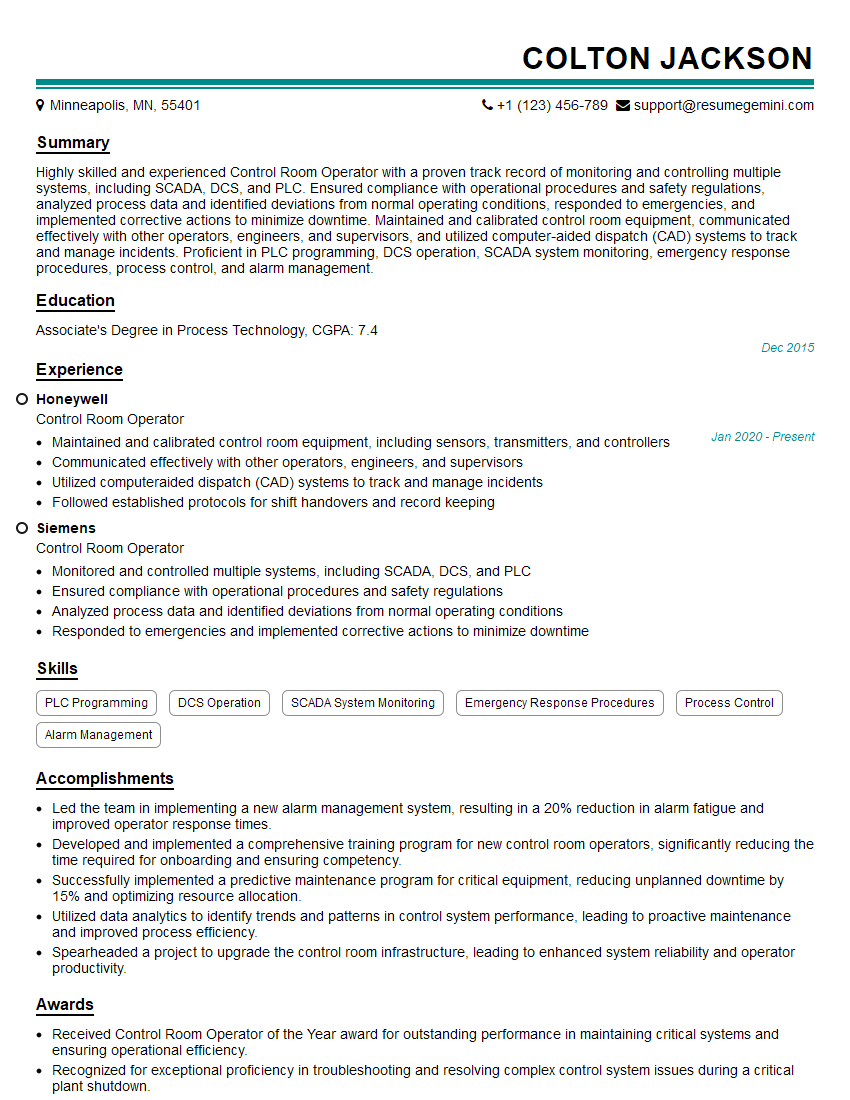Cracking a skill-specific interview, like one for Flame Monitoring and Control, requires understanding the nuances of the role. In this blog, we present the questions you’re most likely to encounter, along with insights into how to answer them effectively. Let’s ensure you’re ready to make a strong impression.
Questions Asked in Flame Monitoring and Control Interview
Q 1. Explain the different types of flame detectors and their operating principles.
Flame detectors are crucial safety devices used to detect the presence of flames in industrial processes. Different types utilize various operating principles to accomplish this. Here are some common examples:
- Ultraviolet (UV) Detectors: These detectors sense the ultraviolet radiation emitted by flames. They’re particularly effective for detecting clear, gas-fueled flames which emit strong UV radiation. Think of them like specialized sunglasses that only see the invisible UV light given off by fire.
- Infrared (IR) Detectors: IR detectors respond to the infrared radiation, or heat, produced by flames. They are more versatile than UV detectors, effective across a wider range of fuels and flame types, even smoky or partially obscured flames. These work similarly to how a thermal camera sees heat signatures.
- Multi-spectral Detectors: Combining both UV and IR detection technologies, these offer enhanced reliability and the ability to differentiate between actual flames and other sources of radiation (e.g., hot surfaces, welding sparks). This gives you a more robust and accurate detection system.
- Flame Image Processing Systems: These sophisticated systems use cameras to capture images and advanced algorithms to identify flame patterns based on color, intensity, and flicker. These are often preferred for larger areas or complex scenarios, offering visual confirmation alongside sensor data.
The choice of flame detector depends heavily on the specific application, considering factors like fuel type, environment (e.g., dusty, smoky), and required response time. For instance, a natural gas burner might use a UV detector, while a solid fuel boiler could need an IR system. A refinery, with its various potential fire hazards, may require a network of multi-spectral and image-processing detectors.
Q 2. Describe the safety instrumented system (SIS) architecture for flame monitoring.
A Safety Instrumented System (SIS) for flame monitoring typically follows a two-out-of-three (2oo3) architecture for high reliability. This means that at least two out of three independent flame detectors must signal a flame failure before triggering a shutdown. This redundancy prevents spurious trips caused by a single detector malfunction.
The architecture usually includes:
- Flame Detectors: As described earlier, multiple detectors are used, often of different types, for increased reliability and diversity.
- Logic Solvers: These process the signals from the flame detectors, evaluating if the specified redundancy criteria (e.g., 2oo3) are met. They’re the brains of the operation, deciding whether to initiate a safety action.
- Final Control Elements (FCEs): These are the actuators responsible for carrying out the safety action (e.g., shutting down fuel supply valves, initiating water deluge systems). They execute the command from the logic solver.
- Human-Machine Interface (HMI): The HMI provides operators with status information, diagnostic data, and the ability to override the system (under very specific and controlled circumstances).
The entire SIS is designed to a high safety integrity level (SIL), typically SIL2 or SIL3, according to industry standards like IEC 61508 or ISA 84. Regular testing and maintenance are vital to ensure the continued effectiveness of this safety-critical system.
Q 3. What are the key performance indicators (KPIs) for a flame monitoring system?
Key Performance Indicators (KPIs) for a flame monitoring system reflect its effectiveness and reliability. Important KPIs include:
- Detection Time: How quickly the system detects a flame failure. A shorter detection time means faster response and mitigation of potential incidents.
- False Alarm Rate: The frequency of false alarms. A high false alarm rate can lead to operator fatigue and desensitization, reducing the system’s effectiveness. Aim for minimal false alarms.
- System Availability: The percentage of time the system is operational and ready to detect flames. High availability is crucial for continuous safety.
- Mean Time Between Failures (MTBF): The average time between system failures. A higher MTBF indicates a more reliable system.
- Mean Time To Repair (MTTR): The average time required to repair a failed component. Faster repair minimizes downtime.
- Diagnostic Coverage: The ability of the system to identify and report the cause of failures. Effective diagnostics expedite troubleshooting and maintenance.
Regular monitoring of these KPIs is essential for optimizing system performance and maintaining a high level of safety.
Q 4. How do you troubleshoot a malfunctioning flame detector?
Troubleshooting a malfunctioning flame detector involves a systematic approach. The first step is to verify that the problem is indeed with the detector and not elsewhere in the system.
Step-by-step troubleshooting:
- Visual Inspection: Check for any obvious physical damage to the detector, wiring, or surrounding equipment.
- Signal Verification: Verify that the detector is sending a signal to the logic solver. Use diagnostic tools to check signal strength and integrity.
- Lens Cleaning: Clean the detector lens to ensure it is not obstructed by dirt, soot, or other contaminants. This is a surprisingly common cause of failure.
- Calibration Check: Verify that the detector has been recently calibrated according to the manufacturer’s specifications. Calibration ensures accurate readings.
- Environmental Factors: Assess whether environmental conditions (e.g., extreme temperatures, excessive dust) could be affecting the detector’s performance. Consider relocating the detector if needed.
- Testing: Use a known flame source (under controlled and safe conditions) to test the detector’s responsiveness. This is a crucial step to isolate the fault.
- Signal Tracing: Trace the signal path from the detector to the logic solver to identify any breaks or faults in the wiring or connections.
If the problem persists after these steps, consider replacing the detector. Always follow lockout/tagout procedures before working on any electrical equipment.
Q 5. Explain the concept of flame verification and its importance.
Flame verification is a critical aspect of flame safety systems. It involves confirming that a detected flame is a genuine flame and not a false signal triggered by something else (like a hot surface). It adds an extra layer of safety.
Importance:
- Prevention of False Shutdowns: Flame verification minimizes the risk of unnecessary process shutdowns caused by false flame detection, leading to increased production uptime.
- Enhanced Safety: By ensuring that only actual flame failures trigger safety actions, flame verification improves the overall safety of the process.
- Compliance: Many safety regulations require flame verification to ensure the robustness of flame safety systems.
Techniques for flame verification can involve using multiple detectors of different types (e.g., UV and IR), analyzing the characteristics of the detected flame (e.g., flicker, intensity), and incorporating additional input signals (e.g., fuel flow). A multi-spectral flame detector inherently offers a degree of built-in verification. For instance, a true flame will exhibit a specific spectral signature across UV and IR bands, making it distinguishable from a hot surface.
Q 6. What are the regulatory requirements for flame monitoring in your industry?
Regulatory requirements for flame monitoring vary depending on the industry, geographic location, and specific application. However, common themes across most regulations include:
- Compliance with relevant standards: Adherence to standards like IEC 61508 (functional safety), IEC 60079 (explosive atmospheres), and local equivalents is mandatory. These standards define safety integrity levels (SILs) and design requirements.
- Regular inspections and maintenance: Periodic inspection, testing, and calibration of flame detectors and the entire SIS are crucial to maintain compliance and ensure system reliability. Detailed records of these activities are essential.
- Documentation: Comprehensive documentation covering the design, installation, operation, and maintenance of the flame monitoring system is required. This typically includes risk assessments, safety plans, and system schematics.
- Emergency response plans: In the event of a flame failure, clear procedures for emergency response and mitigation must be in place and regularly tested. This includes emergency shutdown procedures and worker evacuation plans.
It’s vital to stay updated on the specific regulations applicable to your location and industry to ensure continuous compliance. Consulting with industry experts and regulatory authorities can help navigate these complex requirements.
Q 7. Describe different flame failure scenarios and their mitigation strategies.
Flame failure scenarios can be diverse. Here are some examples and mitigation strategies:
- Fuel Supply Interruption: A loss of fuel can extinguish the flame. Mitigation: Implement a fuel monitoring system that automatically shuts down the system upon fuel failure.
- Airflow Disturbance: Inadequate airflow can cause flame instability or extinction. Mitigation: Use airflow sensors and control systems to maintain optimal airflow levels.
- Ignition Failure: The ignition system might fail to ignite the fuel, leading to flame extinction. Mitigation: Use redundant ignition systems or implement automatic reignition systems.
- Detector Malfunction: A faulty flame detector might fail to detect a flame failure. Mitigation: Use multiple redundant detectors and regular maintenance to ensure detection.
- Abnormal Process Conditions: Changes in operating pressures or temperatures can affect flame stability and cause extinction. Mitigation: Implement process monitoring and control systems to maintain stable operating parameters.
Mitigation strategies often involve redundant systems, automatic shutdowns, interlocks, and regular maintenance. A layered approach, combining multiple strategies, offers the most robust and reliable protection against flame failures. This layered approach aims to manage failures at multiple levels—from preventing the incident from occurring to mitigating its consequences when it does.
Q 8. Explain the role of interlocks in flame monitoring and safety systems.
Interlocks in flame monitoring and safety systems are crucial for preventing hazardous situations. They act as safety mechanisms, ensuring that certain operations only proceed when specific conditions are met. Think of them as a series of checks and balances to prevent accidents. For instance, a burner might only ignite if the flame detector confirms a stable flame is present. If the flame fails, the interlock immediately cuts off the fuel supply, preventing a potentially dangerous gas leak.
In essence, interlocks create a fail-safe system. They link different parts of the process, preventing potentially dangerous actions if pre-defined conditions are not met. This could include interlocks that prevent fuel from flowing unless the correct airflow is established, or that stop the system if the temperature exceeds a safe limit. A common example is the interlock between a flame detector and a fuel valve: no flame detected, fuel valve shuts off.
- Fuel Supply Interlock: Prevents fuel flow unless a flame is detected.
- Airflow Interlock: Prevents ignition unless sufficient airflow is present.
- Temperature Interlock: Shuts down the system if temperatures reach unsafe levels.
Q 9. How do you perform routine maintenance on flame detectors and related equipment?
Routine maintenance is paramount for ensuring the reliability and safety of flame detectors. It’s not just about keeping them running; it’s about preventing catastrophic failures. Imagine a refinery where a faulty detector leads to a significant gas leak – the consequences are severe.
Maintenance involves a multi-step process:
- Visual Inspection: Check for any physical damage, corrosion, or obstructions to the detector’s sensing area. Look for signs of soot buildup, especially on UV detectors.
- Lens Cleaning: Gently clean the lens using a suitable cleaning solution and a soft cloth. Dirty lenses significantly affect detection accuracy.
- Signal Verification: Test the detector’s response to a known flame source (simulated or real, following safety protocols). Verify that the system correctly triggers an alarm or shuts off the fuel supply. Document the test results.
- Calibration: Calibration ensures the detector’s response aligns with factory specifications. This often involves using a calibrated light source. (See question 6 for details)
- Wiring Check: Inspect all wiring and connections for damage or loose connections.
- Documentation: Meticulously record all maintenance activities, including dates, performed tests, and any identified issues. This provides a valuable audit trail.
The frequency of maintenance will vary depending on the application and the detector manufacturer’s recommendations, but it’s usually at least quarterly or annually. A proactive approach minimizes downtime and maximizes safety.
Q 10. What are the common causes of false alarms in flame detection systems?
False alarms in flame detection systems are frustrating and can lead to unnecessary shutdowns. Understanding their causes is essential. Imagine a power plant experiencing a false alarm – it interrupts operations and costs money.
Common causes include:
- Reflective Surfaces: Sunlight reflecting off metallic surfaces can trigger some detectors, especially UV detectors.
- Welding Sparks/Arcs: Intense light sources from welding operations might be misinterpreted as flames.
- Hot Surfaces: Extremely hot surfaces, without open flames, can sometimes generate enough infrared radiation to trigger IR detectors.
- Incandescent Lights: Bright incandescent lights, especially close to the detector, can cause false alarms.
- Dirty Lenses: Accumulated dust or grime on the detector lens can distort the signal and cause misinterpretation.
- Electrical Interference: Electrical noise can interfere with the detector’s electronics, leading to false triggers.
- Calibration Issues: Incorrectly calibrated detectors might have a lower threshold, resulting in false alarms.
Addressing these issues often involves adjusting detector settings, shielding the detector from interfering sources, or implementing better maintenance practices.
Q 11. Explain the difference between UV, IR, and visible light flame detectors.
Flame detectors use different wavelengths of light to identify flames. Each type has its strengths and weaknesses.
- UV Detectors: These detectors respond to the ultraviolet radiation emitted by flames. They are good at detecting small, fast-burning flames and are less prone to false alarms from hot surfaces. However, they can be affected by welding arcs.
- IR Detectors: Infrared detectors sense the heat radiation from flames. They are reliable for detecting larger, slower-burning flames, but can be more susceptible to false alarms from hot surfaces. This type is useful in environments with significant ambient heat sources.
- Visible Light Detectors: These detectors respond to the visible light emitted by flames. They are generally less sensitive than UV or IR detectors and are more prone to false alarms from other light sources. But they are a good, cost-effective option for some applications.
The choice of detector depends on the specific application and the environment. For example, a gas turbine might use UV detectors to quickly detect small flames, while a furnace might use IR detectors because of the higher ambient temperature. Sometimes, a combination of detector types is used for greater reliability and redundancy.
Q 12. How do you ensure the integrity of flame detection signals?
Ensuring the integrity of flame detection signals is critical for safety. A faulty signal can lead to catastrophic consequences. This involves a multi-faceted approach:
- Redundancy: Employing multiple flame detectors or using detectors of different types increases reliability. If one fails, the others will continue to monitor.
- Signal Conditioning: Properly designed signal conditioning circuits filter out noise and improve the signal-to-noise ratio, thus making the flame signal more reliable.
- Regular Testing and Calibration: Routine testing and calibration, as discussed earlier, ensures the detectors are functioning correctly and responding within their specified ranges.
- Signal Verification: Implement signal verification methods that check the validity of the received signal. For example, checking if a signal is within expected ranges or has unusual characteristics.
- Data Logging: Record flame detection data, including timestamps, signal strengths, and alarm events. This allows for later analysis to identify patterns and potential issues.
- Use of proper wiring and connectors: shielding of cables from interference and quality connectors are important.
By combining these measures, you create a robust system that reliably detects flames and minimizes the risk of false alarms or missed detections.
Q 13. Describe the process of calibrating a flame detector.
Calibrating a flame detector is crucial for ensuring its accuracy and reliability. An improperly calibrated detector might miss a flame or trigger false alarms. This process is usually manufacturer-specific, so always consult the manual.
The general steps involved typically include:
- Preparation: Ensure the detector is clean and that the access panels are open for proper calibration access. Turn off the system and lock out/tag out (LOTO) to avoid accidental activation.
- Reference Source: Use a calibrated light source or a simulated flame that emits radiation within the detector’s specified spectral range. The reference source must conform to the detector’s specified requirements.
- Adjustments: Follow the manufacturer’s instructions to adjust the detector’s sensitivity and response settings to match the reference source’s output. This might involve using a calibration tool or software.
- Verification: After making adjustments, retest the detector’s response to the reference source. Ensure it falls within the acceptable range stipulated by the manufacturer’s specifications. Repeat until you obtain accurate readings.
- Documentation: Thoroughly record the calibration date, the reference source used, all adjustments made, and the results of the verification tests.
Regular calibration maintains the accuracy of the detector, ensuring it can reliably detect flames within its design specifications. The frequency of calibration depends on the detector’s type, use, and manufacturer’s recommendations. Often this is annually or even more frequently in some industrial applications.
Q 14. What are the safety precautions when working with flame detectors?
Safety is paramount when working with flame detectors. These devices are often located in hazardous environments, and improper handling can lead to injuries or equipment damage.
Important safety precautions include:
- Lockout/Tagout (LOTO): Always follow LOTO procedures before performing any maintenance or calibration work on flame detectors or related equipment. This prevents accidental activation and minimizes the risk of injury.
- Personal Protective Equipment (PPE): Wear appropriate PPE, including safety glasses, gloves, and flame-resistant clothing, as necessary.
- Proper Ventilation: If working in a confined space, ensure adequate ventilation to prevent buildup of flammable gases or fumes.
- Fire Extinguisher: Have a suitable fire extinguisher readily available in case of an emergency.
- Follow Manufacturer’s Instructions: Always follow the manufacturer’s instructions for installation, maintenance, and calibration procedures.
- Training: Ensure that all personnel working with flame detectors are properly trained and understand the safety procedures.
- Awareness of potential hazards: The environment where the flame detector is installed is critical; there might be additional hazards to consider, like electrical hazards or elevated temperatures.
By adhering to these safety precautions, you can significantly reduce the risk of accidents and ensure a safe working environment.
Q 15. Explain the importance of redundancy in flame monitoring systems.
Redundancy in flame monitoring systems is paramount for safety and reliability. Imagine a power plant – a flame failure can have catastrophic consequences. A single point of failure in the detection system could lead to a dangerous situation going unnoticed. Therefore, redundancy ensures that if one component fails, a backup is immediately available to continue monitoring.
This often involves using multiple, independent flame detectors of different technologies (e.g., UV, IR, and visible light detection) or having duplicate sensors and signal processing units. If one sensor fails to detect the flame, the others will provide confirmation or trigger an alarm. This layered approach dramatically improves the system’s overall availability and minimizes the risk of undetected flame failures.
For example, a system might utilize two UV detectors and one IR detector, with each feeding its own signal processing unit. If one UV detector fails, the system still has a backup UV detector and an IR detector, maintaining continuous monitoring and preventing a false sense of security. The redundancy extends to communication pathways and control systems as well. This ensures that even if one communication line fails, the system can still report and trigger actions through another line.
Career Expert Tips:
- Ace those interviews! Prepare effectively by reviewing the Top 50 Most Common Interview Questions on ResumeGemini.
- Navigate your job search with confidence! Explore a wide range of Career Tips on ResumeGemini. Learn about common challenges and recommendations to overcome them.
- Craft the perfect resume! Master the Art of Resume Writing with ResumeGemini’s guide. Showcase your unique qualifications and achievements effectively.
- Don’t miss out on holiday savings! Build your dream resume with ResumeGemini’s ATS optimized templates.
Q 16. How do you handle a flame detection system failure during operation?
A flame detection system failure during operation requires immediate and decisive action to mitigate risks. The first step is to immediately shut down the burner to prevent potential hazards. This is typically done through a pre-programmed safety shutdown sequence in the Burner Management System (BMS).
Simultaneously, an alarm should be triggered, alerting operators to the failure. The cause of the failure needs to be promptly investigated. This could involve checking sensor wiring, power supply, signal processing units, and communication lines. Depending on the nature of the failure (sensor malfunction, wiring issue, software glitch, etc.), the appropriate corrective action should be taken. This might involve replacing a faulty sensor, repairing damaged wiring, or even rebooting the system’s control units.
While troubleshooting, the system might operate in a degraded mode, using only the redundant elements to maintain some level of monitoring, but with reduced capabilities. A thorough report needs to be documented outlining the sequence of events, the root cause of the failure, and the steps taken to resolve the issue. Preventive maintenance schedules should be reviewed to identify any potential weaknesses in the system and prevent future incidents.
Q 17. What are the different types of burner management systems (BMS)?
Burner Management Systems (BMS) are crucial for safe and efficient combustion processes. They come in various types, each with differing levels of complexity and functionality. The classification can often depend on the application (e.g., industrial boilers, gas turbines, furnaces) and the safety requirements.
Some common types include:
- Simple BMS: These systems provide basic functions like flame detection and fuel shutoff. They are often suitable for smaller, less complex applications.
- Advanced BMS: These include sophisticated features like sequential control, interlocks, automatic purge cycles, and data logging. They’re commonly used in large industrial settings where safety and efficiency are critical.
- Programmable Logic Controller (PLC)-based BMS: PLCs provide flexible control and monitoring capabilities, allowing for customization and integration with other plant systems. They are widely used across many industrial applications.
- Distributed Control System (DCS)-based BMS: DCS systems provide a high level of redundancy, scalability, and reliability. They are particularly relevant for large, complex processes.
The choice of BMS type depends heavily on the specific application’s needs, including size, safety requirements, and level of automation.
Q 18. Explain the role of a PLC in a flame monitoring system.
The Programmable Logic Controller (PLC) acts as the central brain in many flame monitoring systems. It’s a robust, industrial-grade computer that receives signals from various sensors, including flame detectors, pressure sensors, and flow meters. Based on pre-programmed logic and algorithms, it processes this information and makes decisions.
Specifically, the PLC monitors the flame detection signals. If a flame is detected, it confirms that the burner is operating correctly. Conversely, if a flame failure is detected, the PLC initiates a pre-programmed safety sequence, usually including immediate fuel shutoff, air shutoff, and an alarm signal.
Beyond basic safety functions, a PLC can perform advanced functions such as data logging, monitoring burner performance, adjusting fuel/air ratios, and communicating with other systems via various communication protocols. The PLC’s role is fundamental in ensuring safe and efficient operation.
Q 19. Describe the communication protocols used in flame monitoring systems.
Flame monitoring systems utilize various communication protocols for data transmission and control. The choice of protocol depends on factors such as distance, data speed requirements, and the existing infrastructure.
- 4-20 mA Analog Signals: This is a common standard for transmitting analog sensor readings, often used for flame detector signals. It’s simple and robust but can be prone to noise.
- RS-485: This serial communication protocol is commonly used for longer distances and multiple devices. It’s relatively inexpensive and provides a decent data rate.
- Ethernet/IP: Ethernet offers high bandwidth and long distances, enabling advanced communication and data logging capabilities. It’s especially suitable for large-scale systems and network integration.
- Profibus: A fieldbus system designed for industrial automation, it’s used for real-time communication and is widely adopted in process control environments.
- Modbus: Another popular serial communication protocol, it provides a simple and reliable means of data exchange between devices. It’s often used in simpler flame monitoring systems.
Some systems might employ a combination of these protocols to meet diverse communication needs within the system.
Q 20. How do you interpret data from a flame monitoring system?
Interpreting data from a flame monitoring system involves analyzing various parameters to ensure safe and efficient operation. This includes examining flame detection signals, burner operational status, and any error messages.
Flame Detection Signals: These signals indicate the presence or absence of a flame. A consistent, strong signal confirms stable combustion. Fluctuations or complete loss of signal indicate potential problems.
Burner Operational Status: This includes data on fuel flow rate, air flow rate, pressure, and temperature. Deviations from setpoints can reveal inefficiencies or malfunctions. Anomalies here should trigger an investigation of the entire system.
Error Messages: The system may provide error codes indicating specific problems, such as sensor malfunctions, communication failures, or safety system issues. These codes provide essential clues for troubleshooting.
Sophisticated BMS often provides historical data and trends, allowing operators to identify recurring issues, optimize burner performance, and implement predictive maintenance strategies.
Data visualization tools, such as charts and graphs, are crucial for efficient interpretation. Any abnormal patterns or deviations from expected behaviour warrant immediate attention and investigation.
Q 21. What is the significance of flame scan time in a safety system?
Flame scan time, or the frequency at which the flame detector checks for the presence of a flame, is critical for safety. A shorter scan time means more frequent checks, increasing the speed of detection if a flame failure occurs. Conversely, a longer scan time increases the risk of a prolonged period without flame detection before an alarm is triggered.
The acceptable scan time depends on the application and the potential consequences of a flame failure. For high-risk applications, like those involving highly flammable materials or large energy releases, a very short scan time (e.g., a few milliseconds) is essential. For less hazardous applications, longer scan times might be acceptable. However, regulatory requirements and industry best practices usually dictate minimum acceptable scan times for various burner types and applications.
A slower scan time introduces a delay in detecting a flameout, potentially allowing unsafe conditions to develop before the safety system reacts. Therefore, the choice of scan time involves balancing the desired safety level with the cost and complexity of the monitoring equipment.
Q 22. Explain the concept of ‘two-out-of-three’ voting in flame detection.
The ‘two-out-of-three’ voting system in flame detection is a crucial safety measure designed to enhance reliability and prevent false alarms or missed detections. It works by using three independent flame detectors. If at least two out of the three detectors sense a flame, the system triggers an alarm and initiates the appropriate safety response (e.g., shutting down fuel supply). This redundancy significantly reduces the risk of system failure due to a single detector malfunction or environmental interference.
Think of it like a voting process: two or more votes (detections) are required for a conclusive action. This prevents a single faulty detector from causing an unnecessary shutdown or a missed critical alarm. For instance, if one detector fails due to a temporary obstruction like dust or water, the other two can still correctly identify the flame and trigger the appropriate response.
Q 23. How do you handle a situation where multiple flame detectors show conflicting readings?
Conflicting readings from multiple flame detectors indicate a problem that needs immediate attention. The first step is to investigate the root cause of the discrepancy. This involves checking for:
- Detector malfunction: Individual detector health checks, including verification of power supply, signal strength, and lens cleanliness, are crucial.
- Environmental factors: Conditions like excessive dust, water spray, or intense light can interfere with flame detection. The environmental conditions near each detector should be assessed.
- Flame characteristics: The type and intensity of the flame can influence the readings from different detection technologies. A flickering or unsteady flame might be detected inconsistently by different detectors.
After identifying the cause, corrective actions can be taken. This may involve cleaning or replacing faulty detectors, adjusting detector placement, or improving environmental controls. In the meantime, a cautious approach must be adopted, possibly including a temporary manual shutdown of the process until the issue is resolved and detectors are validated.
Q 24. Describe the process for commissioning a new flame monitoring system.
Commissioning a new flame monitoring system is a rigorous process to ensure its accurate and reliable operation. It typically includes these steps:
- System design review: Verifying the system design meets the specific application requirements, including the flame characteristics, environmental conditions, and safety requirements.
- Installation and wiring verification: Confirming proper installation of all detectors, control panels, and other components and verifying the integrity of all wiring connections to prevent short circuits or signal degradation.
- Detector calibration and testing: Using calibrated test equipment, each detector is individually tested to ensure it is functioning correctly within its specified parameters. This often involves using a calibrated test flame simulator.
- System testing: Simulating different flame scenarios, including normal operation and potential failure modes, to verify the system’s overall functionality and response times.
- Documentation and handover: Creating comprehensive documentation for future reference, including installation details, calibration records, and system performance data. This documentation is critical for routine maintenance and troubleshooting.
Thorough commissioning minimizes the risk of failures and ensures the system protects personnel and equipment effectively.
Q 25. What is the difference between preventative and corrective maintenance for flame safety systems?
Preventative and corrective maintenance are essential for maintaining the reliability and safety of flame safety systems. Preventative maintenance involves scheduled inspections, cleaning, and testing to prevent failures before they occur. This includes regular checks of detectors, control panels, and wiring, as well as periodic functional tests and calibrations.
Corrective maintenance, on the other hand, is performed after a failure occurs. It involves troubleshooting, repairing, or replacing faulty components. Corrective maintenance is reactive and typically more costly and time-consuming than preventative maintenance. A well-maintained system relies heavily on a proactive preventative schedule to minimize the need for costly and potentially dangerous corrective actions.
For example, preventative maintenance might involve a monthly visual inspection of detectors for cleanliness, while corrective maintenance would be required if a detector is damaged and needs replacement.
Q 26. Explain the importance of documentation and record-keeping in flame safety systems.
Documentation and record-keeping are paramount for ensuring the long-term safety and reliability of flame safety systems. Detailed records demonstrate compliance with safety standards, facilitate efficient troubleshooting, and provide a history of the system’s performance.
Key records include installation documentation, calibration certificates, maintenance logs, testing results, and any reports of system events. This documentation is crucial for audits, insurance purposes, and for tracking the system’s overall health and performance over time. Poor documentation can lead to difficulties in identifying the root cause of a failure and can impede future maintenance or repairs.
Q 27. Describe your experience with different flame detection technologies (e.g., UV, IR, etc.).
I have extensive experience with various flame detection technologies, including:
- Ultraviolet (UV) detectors: These are highly sensitive to the UV radiation emitted by flames, making them suitable for detecting flames even in smoky or dusty environments. However, they can be susceptible to interference from other sources of UV radiation, like welding arcs.
- Infrared (IR) detectors: These detect the heat radiation emitted by flames. They are generally less susceptible to environmental interference than UV detectors, but may be less sensitive to small or cool flames.
- Multi-spectral detectors: Combining UV and IR detection offers the benefits of both technologies, improving overall reliability and reducing false alarms. They are often preferred for their enhanced accuracy and sensitivity to various flame types.
My experience also encompasses selecting the most appropriate technology for different applications, considering factors such as flame type, environment, and safety requirements. For example, in a refinery environment, the robust nature and resistance to environmental interference of multi-spectral detectors are often preferable over UV detectors.
Q 28. How do you ensure compliance with relevant safety standards and regulations?
Ensuring compliance with relevant safety standards and regulations is a critical aspect of my work. This involves:
- Staying updated: I actively monitor changes and updates to relevant codes and standards, such as those from NFPA, IEC, and other applicable regional regulatory bodies.
- System design and selection: Selecting flame detection systems that meet or exceed the required standards for the specific application and ensuring that the design adheres to all applicable regulations.
- Regular testing and inspection: Implementing and adhering to a comprehensive maintenance schedule for the system to ensure compliance with relevant performance and safety requirements.
- Documentation and record-keeping: Maintaining accurate and detailed documentation to verify compliance. This includes all testing results and maintenance logs.
- Professional development: Continuously updating my knowledge and skills through training and certifications to remain current with industry best practices and evolving regulations.
Compliance is not simply a matter of following regulations; it is a commitment to protecting personnel and preventing accidents.
Key Topics to Learn for Flame Monitoring and Control Interview
- Flame Detection Technologies: Understanding various flame detection methods (UV, IR, visible light) including their principles, advantages, disadvantages, and applications in different industrial settings. Consider factors like sensitivity, response time, and false alarm rates.
- Control System Architectures: Familiarize yourself with different control system architectures used in flame monitoring and control, such as PLC-based systems, distributed control systems (DCS), and safety instrumented systems (SIS). Understand the role of each component and how they interact.
- Safety and Regulatory Compliance: Deep dive into relevant safety standards and regulations (e.g., NFPA, IEC) pertaining to flame monitoring and control systems. Understand the importance of safety interlocks, redundancy, and fail-safe mechanisms.
- Troubleshooting and Diagnostics: Develop your problem-solving skills by exploring common issues in flame monitoring systems, such as false alarms, sensor failures, and control system malfunctions. Practice diagnosing problems and implementing effective solutions.
- Burner Management Systems: Gain a strong understanding of how flame monitoring integrates with burner management systems (BMS) to ensure safe and efficient combustion processes. This includes understanding fuel-air ratios, ignition sequences, and shutdown procedures.
- Data Acquisition and Analysis: Learn about data logging and analysis techniques used in flame monitoring. Understand how to interpret data to identify trends, predict potential issues, and optimize system performance.
- Maintenance and Calibration: Become familiar with the maintenance procedures and calibration techniques required to ensure the accuracy and reliability of flame monitoring and control systems. This includes preventative maintenance schedules and troubleshooting procedures.
Next Steps
Mastering Flame Monitoring and Control opens doors to exciting career opportunities in various industries, offering excellent growth potential and high demand. A well-crafted resume is your key to unlocking these opportunities. To significantly increase your chances of landing your dream job, create an ATS-friendly resume that highlights your skills and experience effectively. We recommend using ResumeGemini, a trusted resource for building professional resumes. ResumeGemini provides examples of resumes tailored to Flame Monitoring and Control to help you craft a compelling document that showcases your qualifications. This will ensure your application stands out and gets noticed by recruiters.
Explore more articles
Users Rating of Our Blogs
Share Your Experience
We value your feedback! Please rate our content and share your thoughts (optional).
What Readers Say About Our Blog
Hi, I have something for you and recorded a quick Loom video to show the kind of value I can bring to you.
Even if we don’t work together, I’m confident you’ll take away something valuable and learn a few new ideas.
Here’s the link: https://bit.ly/loom-video-daniel
Would love your thoughts after watching!
– Daniel
This was kind of a unique content I found around the specialized skills. Very helpful questions and good detailed answers.
Very Helpful blog, thank you Interviewgemini team.


